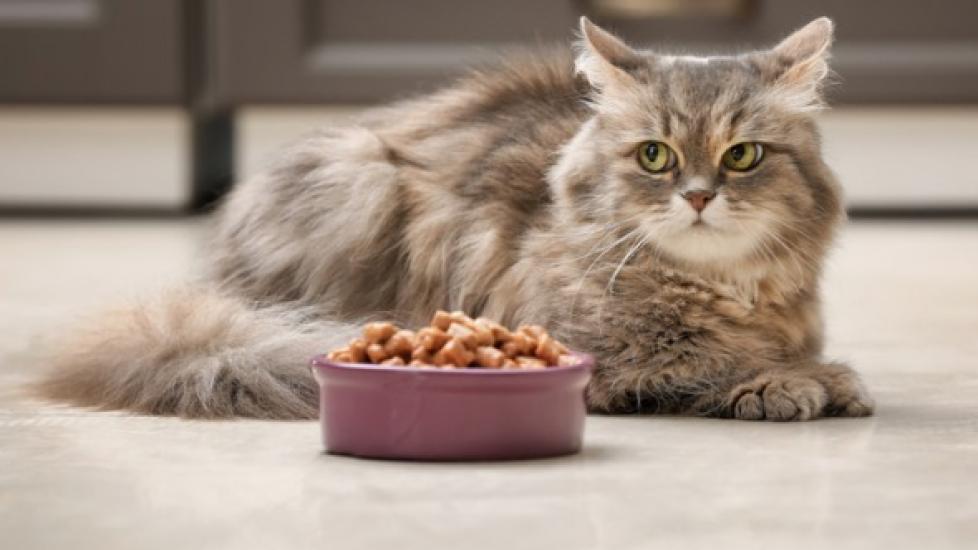Can Cats Eat Dog Food?
This is a common question to come up in the course of a veterinary visit.
The short answer is yes, a cat can eat a small amount of dog and not have any toxicity or lasting effects.
However, the longer answer dives into the species-specific differences between our feline and canine friends. While a nibble of stolen dog food will not harm cats, it will definitely not help them achieve their best possible health.
Here’s what you need to know about cat nutrition and why you should not feed dog food to cats in the long-term.
Can Cats Safely Eat Dog Food Long-Term?
No, cats cannot be maintained on a dog food diet.
If a cat is only fed dog food for a long period of time, then detrimental, if not deadly, consequences can occur.
This is because dog food and cat food formulas have different nutritional components in order to meet the different nutritional needs of these two species.
Cats and Dogs Have Different Nutritional Needs
While both dogs and cats share our hearts and homes, over time, nature has molded them into very different animals with very different nutritional needs.
Cats are obligate carnivores, which means that they require a diet of meat-based proteins and animal fats in order for all of their body systems to function properly.
Dogs, on the other hand, are actually omnivores. An omnivore has a more flexible diet and can easily eat both meat and vegetables. A dog food diet does not meet the specific nutritional needs that cats require.
Differences Between Cat Food and Dog Food
Here are just a few key differences in the formulation of dog food and cat food.
Taste
Cats perceive taste differently than dogs. Cats, unlike dogs, lack of the ability to sense sweetness, and even the number of taste receptors are different between the two species.
Cats have a measly 470 taste buds, while dogs have 1700—for reference, humans have over 9000.
Cat foods are specifically engineered to be highly palatable in order to entice our occasionally picky (and taste-bud lacking) feline friends to eat.
*Side note: It’s generally uncommon for cats to even want to eat dog food, as they tend to find it unappetizing. Dogs, however, love the delicious, high-protein content in cat food.
Protein
As strict carnivores by nature, cats need food that has a much higher protein content than dog food does.
Occasional brands and types of dog food do feature higher protein levels, but as a whole, not even these specialized dog foods reach the high level of protein needed to keep cats healthy.
Most dog foods have an “As-Fed” protein amount of 18-26%. For cats, however, I usually recommend to aim for at least an “As-Fed” protein percentage of 30-34%, with an optional supplement of canned cat food with 40-50% protein.
Taurine
Cats (and humans) are among a few of the mammals that don’t have the ability to make taurine, so they must get this essential element from their diet.
Cats that lack taurine in their diet can have:
-
Weakened hearts (dilatated cardiomyopathy)
-
Loss of vision
-
Digestion problems
All commercially available cat food today has taurine added; however, it is rarely included in dog foods.
Arachidonic Acid
Arachidonic acid is a fatty acid that cannot be created by cats either—it must be ingested.
Cats suffering from low arachidonic-acid levels have nonspecific signs of illness, such as:
-
Abnormal liver/kidney values
-
Occasionally, increased skin issues
Dogs can create this fatty acid all by themselves, and thus, dog food is seldom supplemented with it.
Vitamin A
Vitamin A is yet another dietary element that cats cannot synthesize on their own and must have supplemented in their diet.
While dog foods do often contain vitamin A supplements, these foods will never contain high enough amounts for optimal cat nutrition.
Cats suffering from lack of vitamin A will have:
-
Poor quality coats
-
Muscle weakness and deterioration
-
Possible night blindness
Niacin
It’s important that a cat’s diet also contain niacin, as cats cannot make their own.
Animal tissue is the most common source of niacin in cat food; but plants do have low levels of niacin. But a food containing a lower content of animal tissue and higher contents of plant tissue, such as grains, may not give cats the proper levels of niacin they need.
Life Stage Is Also Important
There is an organization called the Association of American Feed Control Officials (more commonly called AAFCO) that closely monitors and regulates the pet food industry.
The pet foods that follow AAFCO’s nationally agreed upon nutritional levels will have a label stating: “…formulated to meet the AAFCO Cat Food Nutrient Profile for… (a life stage).”
Life stages fall into three main groups in the pet food industry:
-
Growth
-
Maintenance
-
All-life stages
Not only do cats have specific overall protein, vitamin, and nutritional needs, but these vary throughout their life stages as well.
Fast-growing kittens need more nutrients and energy sources, while older, healthy cats need more protein to help maintain their muscles as they age.
Dog food—with its lower percentages of proteins and other nutrients—cannot possibly sustain a cat long-term at any one of their life stages.
A High-Quality Cat Food Is Essential
The best way to ensure that cats share our lives for a very long time is to ensure they get a healthy, high-quality diet that’s geared to meet feline needs.
While dog food is nontoxic and will not cause harm if a few kibbles are eaten, it is not designed to meet a cat’s nutritional needs.
Featured Image: iStock.com/srezniy
